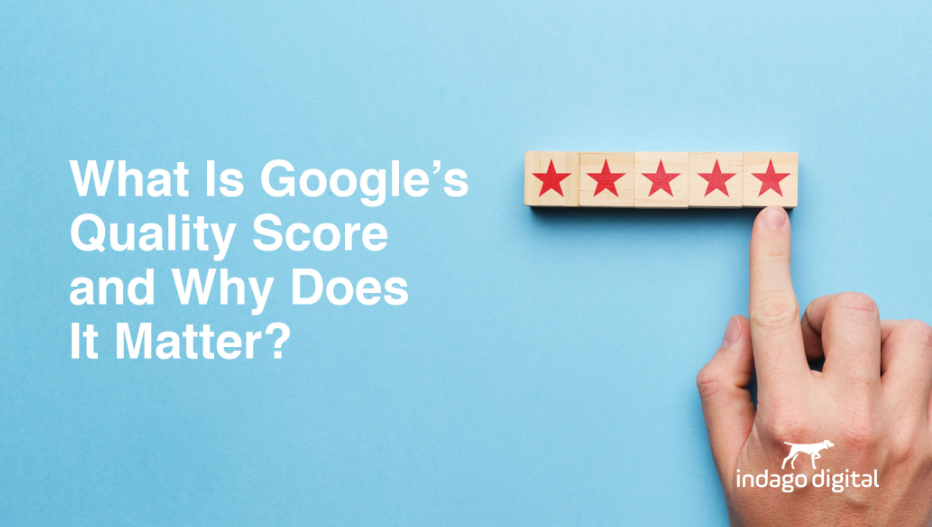What is Google’s quality score and why does it matter?
Google’s Quality Score is a ranking the search engine applies to keywords to improve the quality and relevancy of its ads and enhance user experience. It’s a diagnostic tool for advertisers that indicates how relevant an ad and its associated landing page are to what users search. The score is represented on a scale from 1 to 10, with one being the lowest and ten being the highest.
Why does it matter? Because the higher your Quality Score is, the lower your pay per click will be in the auction and the better your ad position will be.
Finding your quality score
To access your score, navigate to ‘Search Keywords’ and modify columns to include Quality Score. When assessing your performance, include a historical Quality Score for the reporting period (see example). You can compare period on period and see the score changes over time. In addition, you can manipulate date ranges to see if there is any valuable historical information.
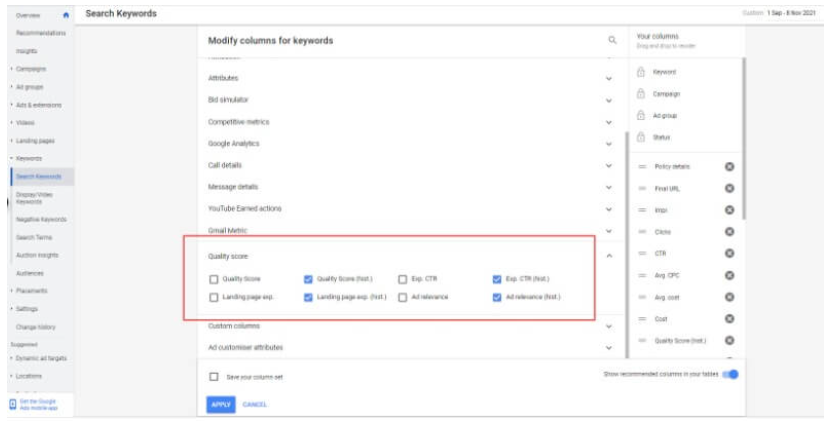
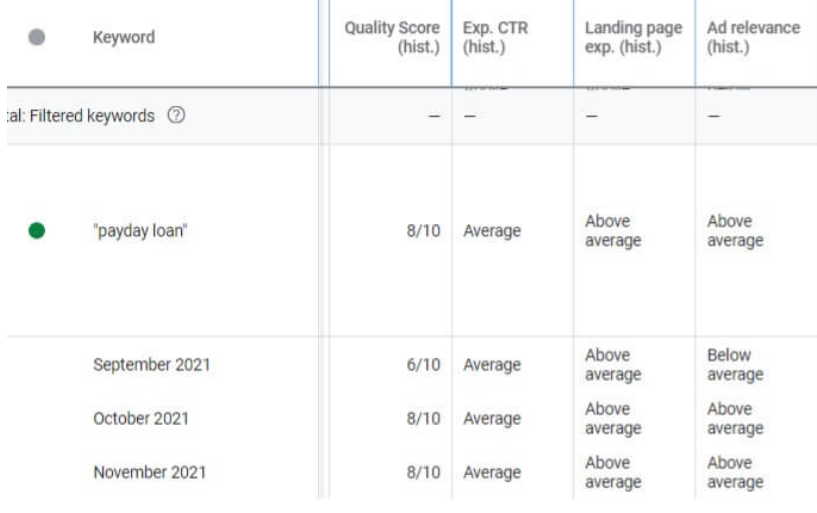
How Does It Work?
Your search ranking is calculated based on the combined performance of three components:
- The ad's relevance to the keyword – does the information in your ad correspond to the search intent?
- The ad's relevance to your landing page – is the information on your landing page relevant to what people search for and your ad copy?
- The ad's click-through rate – how likely are people to click on your ads?
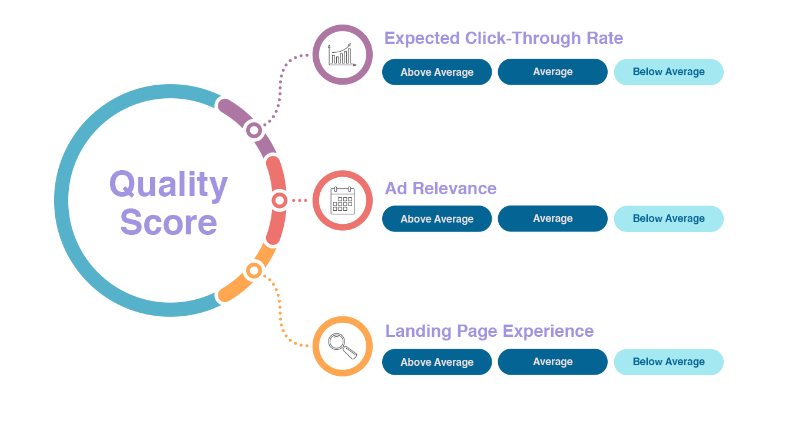
Improving your ads and landing pages and tailoring them more closely to what people are looking for will improve your expected click-through rate and, in turn, your account’s overall performance.
Quality Score impacts your performance because it helps Google determine your ad rank. Your ad rank is identified by multiplying your Max CPC bid by the Quality Score.

Expected click-through-rate
is represented by the likeliness of the ad receiving a click when it appears on the search engine results page (SERP). Some research shows that it is the biggest factor in identifying a Quality Score. It is different from just the regular click-through rate in the advertising account. Google considers the keyword performance and other advertising accounts targeting the same keyword.
Expected CTR is impacted by your ad relevance and landing page experience; however, there might be situations where your keyword and ad copy match perfectly, but your ad is triggered by irrelevant searches, which decreases your expected CTR. This can be discovered in the search terms reports by examining the individual search queries and irrelevant themes triggering ads.
Negating irrelevant terms and adjusting keyword match types with smart bidding can improve the account’s expected CTR and, therefore, your overall score. It can take time for your score to improve, so don’t be disheartened if you don’t see improvements immediately. Google doesn’t give any exact indicators of the time it takes for changes to be reflected in scores, but it’s commonly believed that it takes around 1,000 impressions per keyword to update.
Ad Relevance
Reflects how well your ad's message matches the keywords you’re targeting and your corresponding landing page. There are three possible ad relevance statuses:
- Above average
- Average
- Below average
An ‘Average’ or ‘Above average’ status indicates that you have no major issues with your ad relevance compared to all other ads across Google Ads. The closer the keyword and ad copy connection, the higher the ad relevance.
Incorporate the keywords you target into your ad copy to improve' Below average' ad relevance. Reword your ad copy to include as many keywords in the headlines, ad descriptions, or path fields from your display URL as possible. Also, the information you put in your ad should always correspond to your landing page and vice versa.
In addition, Google offers a few advanced features to improve ad relevance by allowing dynamic updates to the text of your ads depending on what people search:
- Dynamic Keyword Insertion, or DKI helps to insert different characteristics or descriptions that people search for the same product that you offer. For example, let’s say you promote personal loans. DKI would automatically add different loan types to your ad copy.
- Location insertion customises your ad to your users’ locations. Instead of writing individual ad variations for each location, you can just insert a piece of code, and Google Ads will try to replace this code with the location from your campaign.
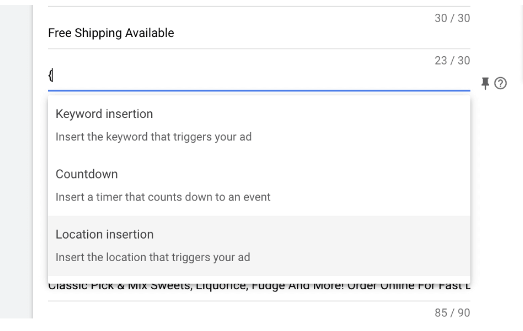
Landing Page Experience
defines how useful and easy to navigate your landing page is to someone who clicks the ad. Google Ads uses the same statuses for each factor of the quality Score:
- Above average
- Average
- Below average
To score an ‘Above average’ for your landing page experience, it should match the keyword you target as well as the information that you promote in your ad. You need to ensure that the messaging from the ad copy is carried over to the content on the landing page. Your landing page experience also takes the technical quality of the page into consideration, i.e., where you send the traffic, how well it is organised and if the user can easily access all the necessary information to complete their customer journey. Your website should be easy to navigate, fast to download on different devices and mobile-friendly. Use this Google tool to show page speed on mobile and mobile friendliness.
What’s considered a ‘good’ quality score?
That depends on what kind of keyword we’re bidding on:
- Branded keywords: between 8 – 10
- High-intent commercial keywords: 7 – 9
- Low-intent keywords: 7
- Competitor keywords: 3+
Your ad account's structure could also help improve your Quality Score. If you can split your keywords into different themes and then create specific ad groups for each theme and more closely tailor your ads to the topic, that would make your ads more specific and more relevant to what people search. It’s also important to regularly exclude unnecessary keywords that waste your budget and don’t convert and eliminate the keywords that have very low search volume and don’t convert. When your Quality Score remains low despite your efforts, it’s best to pause those keywords and focus on others with more potential.
It’s essential to make your ad text clear and compelling to connect your potential customers as closely as possible with your landing page. You should highlight the unique benefits of your product, such as free delivery or a seasonal discount. You should experiment with your call to action and make them strong and consistently focused on the action you want your website visitor to complete, i.e., ‘Sign Up for a Trial’, ‘Buy’, ‘Sell’, ‘Get a Quote’, etc. Finally, don’t hesitate to create a sense of urgency and highlight upcoming promotional events with countdown ad customisers.
Test multiple ads, experiment with different offers, keywords, and ad copy and add at least four different ad extensions, including visual ad extensions. An absolute minimum would be image extensions and site links.
Conclusion
Quality Score – A Useful Diagnostic Tool, Not a KPI
Advertisers must regularly look at their Quality Score to make sure it isn’t languishing and driving up costs. Pay attention to the three factors that affect Quality Score – expected click-through rate (CTR), ad relevance, and landing page experience. Working on these to improve your Quality Score helps you to maximise your ad budget and achieve more results with less spend.
Quality Score is a very useful diagnostic tool, but it’s not the holy grail. Keywords with low Quality Scores can still perform well, and sometimes even better than higher Quality Score keywords. And competitor keywords will always have a low Quality Score but can still convert well.
Don’t become obsessed with scoring a perfect 10 for every keyword. Consider the specifics of your business and the overall performance of your account. Become obsessed with metrics that ‘move the needle’, like improving your conversion rates, and your sales funnel, tracking and lifetime values. Improving your Quality Score is one of the many tactics you can employ to achieve these higher value goals.
Written by
Luke Ashmore-Delaney

